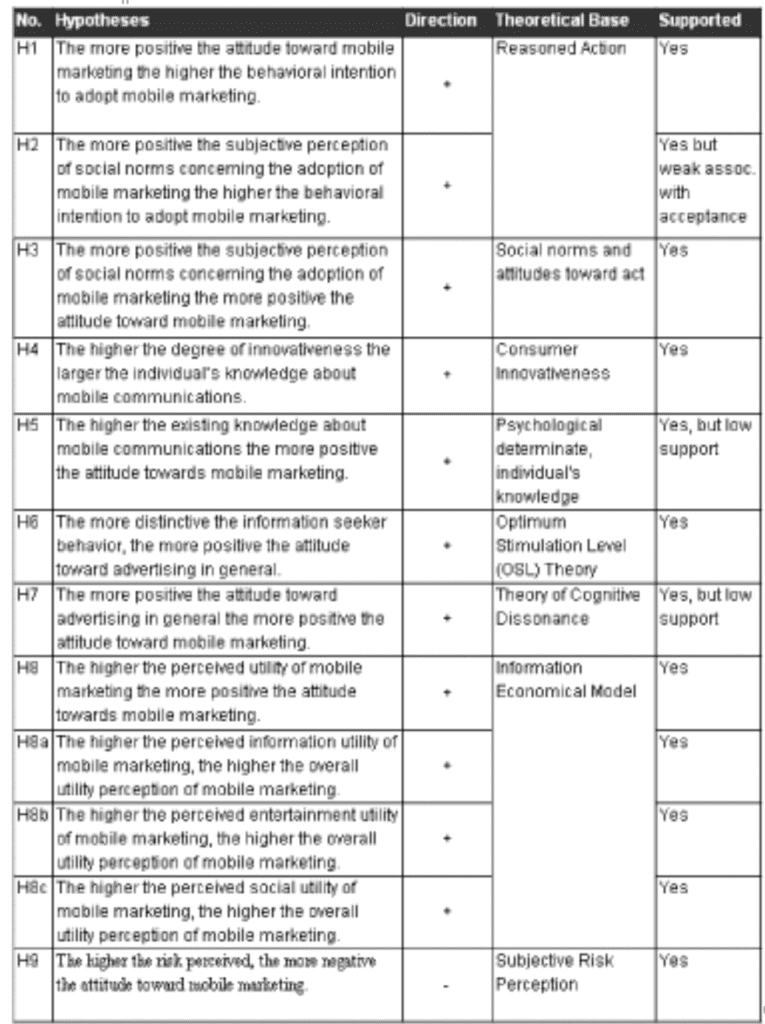"The attributes inherent to mobile marketing - i.e., personalization, ubiquity [i.e. anytime anywhere access], interactivity, and localization - generate the significant potential for this innovative form of commercial communication." (Bauer et al. 2005)
In 1997 there were 297 million mobile subscribers worldwide and in just 10 years the subscriber rate has ballooned to an incredible 1.8 billion (Bauer et al. 2005, World Telecoms 2005). This rapid growth is expected to continue with subscriber rates more than doubling to 3.9 billion, or 50% of the world’s population, in the next 5 years (Worldwide Mobile Market 2006). Europe is the most mature market with 96% penetration rates, followed by Japan (79%), the United States (64%), and the rest of the world is following suit with increased rates of mobile services adoption (World Telecoms 2005). Mobile subscribers are no longer relying voice services only. With the introduction of data services, SMS, MMS, Mobile Internet, etc., the mobile phone and network is rapidly becoming a viable commercial marketing channel. However, as Hans Bauer, Stuart Barnes, Tina Reichardt, and Marcus Neumann point out in their 2005 article, Driving Consumer Acceptance of Mobile Marketing: A Theoretical Framework and Empirical Study, “even though companies are investing heavily in mobile marketing…the nature and implications of this channel are not yet understood fully” and studies need to be performed to understand how to best utilize it (Bauer et al. 2005, P 181). There is scant research or theory to help guide marketers and researchers on how to most effectively use the mobile medium for marketing. This paper provides a detailed review of the Bauer study which illuminates many elements that influence consumer acceptance of the mobile marketing medium.

Mobile marketing, the practice of leveraging the mobile channel for marketing, is becoming an increasingly popular element of the marketing mix (PEAR 2006). A broad range of major and minor products and services firms like Nike, Coca-Cola, NBC, IGN, Gawker, and Simon & Schuster with the recent launch of Stephen King’s new novel “Cell” have begun to leverage the mobile medium to reach out and engage their prospects and customers. To date, SMS, or short message service (a.k.a text messaging) has been the primary medium for mobile marketing, with MMS and Mobile Internet far behind, which is not surprising given the broad use of SMS today and the limited diffusion and adoption of these other technologies. “In 2005, the total number of SMS messages sent globally totaled 670 billion and this figure is expected to rise to 2.6 trillion by 2007” (Bauer et. Al 2005).
The use of SMS for commercial purposes, e.g. wireless advertising, or which many of the above messages are commercial (as far back as 2002 the Yankee Group estimated 15% of global 2004 SMS traffic would be commercial (Yankee Group 2002)), seems to be uneven between mature and immature markets. In a mature mobile market, like Finland, consumer exposure to mobile marketing is reported to be between 50%-70%, up sharply from 2000. A Mobile Media Tracking survey reports 50% of mobile subscribers in Finland have received a mobile marketing message on their mobile phone, in contrast to 10% in 2000 (Finland 2005). While, a December 2005 study by the PEAR Project, also in Finland, found that “70% of Finish consumers have received mobile marketing in the form of SMS during the last month.” Furthermore, 10% of these respondents report having bought a product due to their receipt of an SMS ad (PEAR 2006, P1). The PEAR study also reported that consumers found a maximum of four advertising text messages a suitable number of mobile marketing messages to receive per week. For additional results from the PEAR study visit http://www.pear.fi/english/pr/PEAR_SURVEY_FIGURES_FOR_PRESS.doc
While in the U.S., arguably an immature but rapidly growing market for mobile marketing, the numbers are mixed. The Yankee Group found that in 2004 20% of U.S. mobile subscribers had received a wireless ad and “of that group, 9% said the ad bothered them, while another 9% said they ‘just deleted it.’ Only 2% said they received an ad that was “relevant for me” (Steinbock 2005), while a Mobile Marketing Association (2005) study reported that 25% of their study sample has interest in mobile marketing, with 3% of the sample reporting having experience with mobile marketing. Also in 2005, Hanley (2005) found that in a study of college students 33% of the study sample reported receiving advertisements on their cell phone, up 9% since February 2005. Hanley also found that with incentives 66% of the students would accept cell phone ads (Hanley et al 2005). Even with these recent reports, still very little is known or has been proven about how or why consumers are responding to mobile marketing or what influences their acceptance of it.
Mobile marketing adoption and acceptance are on the rise, but without a clear understanding of the elements driving consumer acceptance, marketers will have little ability to consistently generate positive returns from their programs (Becker 2005). In their study, Bauer et al. conducted a thorough review of the literature and applicable theory in order to identify the influential variables affecting consumer acceptance and to build a framework to help understand the interaction between these variables.
A critical first step in building a framework like the one proposed by the authors is to look at existing theory and models, the theory being repeatedly tested statements that help explain a phenomenon and models being proposed but insufficiently tested statements. In their study, the authors pulled from a number of theories and models to help them understand the complex practice of mobile marketing and to develop their framework for consumer acceptance of mobile marketing, including the Theory of Reasoned Action, Innovation Theory, Optimum Stimulation Level (OSL) Theory, Theory of Cognitive Dissonance, and the Information Economical Model. Out of their literature review and review of these theories, the author’s identified, hypothesized, tested and found a number of variables (constructs) that influence consumer acceptance of mobile marketing (see Table 1). These variables include a consumer’s behavioral intentions, attitude to act, and adopted social norms, as well as a consumer’s prior experience and knowledge of mobile communications, the consumer’s demand for information as explained by OSL theory and the consumer’s attitude toward advertising in general. The authors also identified perceived utility, i.e. does consumer perceive the marketing message to contain information or entertainment value, and perceived risk i.e. does the consumer perceive a risk of lost privacy and data miss-use if they were to engage the marketer, as key determinants of a consumer’s acceptance of mobile marketing.
As shown in Table 1, the authors conclude that all these variables do in fact influence a consumer’s propensity to accept mobile marketing, however, some more than others. They found that a consumer’s attitude toward mobile marketing is a strong determinant of their behavioral intention to use mobile marketing (H1), that behavioral intention is positively influenced, but weakly, by social norms (H2), and that social norms are strongly influenced by attitude (H3). They also concluded that innovativeness, i.e. the consumer’s willingness to adapt and try new innovations, is a positive predictor of their knowledge about mobile communications (H4) and that the level too which consumers’ seek information, i.e. look for stimuli, determines their attitude toward advertising (H6). However, the influential effect is low for some of these variables, such as attitude toward advertising and mobile marketing (H5, H7). But, while the above variables were found to influence a consumer’s acceptance of mobile marketing, they were not the primary drivers. The authors concluded that, based on the results of their study, a consumer’s perceived utility (H8), i.e. does the consumer perceive the mobile interchange to be informative or entertaining, as the “central driver of the consumer acceptance of mobile marketing” (Bauer et al. 2005, PG 188). In other words, “only if mobile marketing messages are designed creatively and are entertaining, or if they prove a high information value, will consumers develop a positive attitude toward mobile marketing… marketers should definitely be advised against using imperialized mass messages for communicating advertising content” (Bauer et al. 2005, PG 189). Likewise, they found that perceived risk negatively influences a consumer’s willingness to accept mobile marketing (H9). These findings may sound obvious; however, this study is one of the first where these construct interactions have been empirically tested and validated as key determinants to mobile market acceptance. Therefore, rather than working on intuitive conjecture marketers may now include these constructs in the design of their mobile campaigns with more confidence and expect a positive outcome from their mobile marketing initiatives, since now there is a tested theoretical basis to do so. However, as pointed out by the authors, caution is warranted since there is much research still to be done.
The mobile marketing phenomenon is incredibly complex, and little is understood or has been proven about how it really works or what influences consumer response and acceptance to use the medium. Research, like the Bauer study, is important because it contributes to the limited but growing theoretical foundation that marketers can use to understand the consumer and provide insight into how to best apply the mobile marketing medium to achieve their marketing goals. Mobile marketing is an invasive medium. Future research is warranted and caution should be taken when applying research results from just a few studies at this early stage of market development. The authors recommend that future research be conducted on 1) examining mobile marketing tools, 2) how to create and increase information and entertainment value of mobile marketing, and 3) better understanding the issues of risk perception. The outlook is positive for mobile marketing, but there is still much work to do.
References
CTIA. (2005, 27/Sept.). Mobile Marketing Association. In Marketing- The Mobile Channel. CTIA Wireless I.T. & Entertainment 2005 San Francisco: Mobile Marketing Association & CTIA.
Bauer, H., Barnes, S., Reichardt, T., & Neumann, M. (2005). Driving Consumer Acceptance of Mobile Marketing: A Theoretical Framework and Empirical Study. Journal of Electronic Commerce & Research, 6(3).
Becker, M. (2005, 11/Nov). Effectiveness of Mobile Channel Additions and A Conceptual Model Detailing the Interaction of Influential Variables. Retrieved 11/2/06, from http://www.iloopmobile.com/news/mb_research_111705.htm.
Finland: Mobile marketing reaches nearly half of Finns. (2005, 16/Dec.). Retrieved 11/2/06, from eFinland: http://e.finland.fi/netcomm/news/showarticle.asp?intNWSAID=45302.
Hanley, M., Martinsen, J., & Pryor, L. (2005, November). College Cell Phone Advertising Survey., Department of Journalism, Ball State University.
Mobile Marketing Effectiveness Study. Mobile Marketing Association. (2005). Mobile Marketing Association. www.mmaglobal.com.
PEAR - Personalized Mobile Advertising Services. (2006, 1/Feb). Finnish Consumers Welcome Mobile Marketing - Press Release. Retrieved 11/2/06, from http://www.pear.fi/english/pr.php?p1=1.
Rettie, Ruth, Ursula Grandcolas, and Bethan Deakins Text Message Advertising: Dramatic Effect on Purchase Intension. Kingston University & BT.
Rudestam, K., & Newton, R. (2001). Surviving Your Dissertation ( 2nd, Ed.). Thousand Oaks: Sage Publications.
Steinbock, D. (2005, 06/02/11). The Mobile Revolution. London: Kogan Page.
World telecoms and technology outlook: Demanding times. (2005, 31/Aug). The Economist Intelligence Unit.
Worldwide Mobile Market Forecasts 2006-2011. (2006, 18/Jan). Retrieved 11/2/06, from Portio Research: http://www.portioresearch.com/WMMF06-11.html.
Zawel, Adam 2002 Wireless Advertising: Still Waiting for Takeoff. Electronic document. http://www.yankeegroup.com/public/pro ... research_note.jsp?ID=8907 Boston.
Credits: Image by Mustafa shehadeh from Pixabay

No Comments.